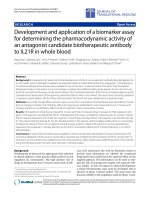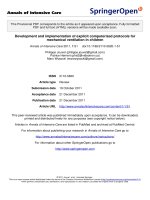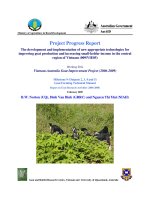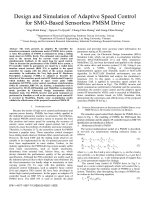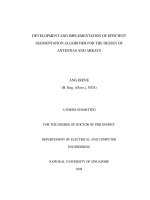Development and interpretation of machine learning models for drug discovery
Bạn đang xem bản rút gọn của tài liệu. Xem và tải ngay bản đầy đủ của tài liệu tại đây (13.35 MB, 167 trang )
Development and Interpretation of
Machine Learning Models for Drug
Discovery
Kumulative Dissertation
zur Erlangung des Doktorgrades (Dr. rer. nat.)
der Mathematisch-Naturwissenschaftlichen Fakult¨at
der Rheinischen Friedrich-Wilhelms-Universit¨at Bonn
vorgelegt von
Jenny Balfer
aus Bergisch Gladbach
Bonn 2015
Angefertigt mit Genehmigung der Mathematisch-Naturwissenschaftlichen Fakult¨at der
Rheinischen Friedrich-Wilhelms-Universit¨at Bonn
1. Gutachter: Prof. Dr. J¨
urgen Bajorath
2. Gutachter: Prof. Dr. Andreas Weber
Tag der Promotion: 22. Oktober 2015
Erscheinungsjahr: 2015
Abstract
In drug discovery, domain experts from different fields such as medicinal chemistry,
biology, and computer science often collaborate to develop novel pharmaceutical agents.
Computational models developed in this process must be correct and reliable, but at
the same time interpretable. Their findings have to be accessible by experts from other
fields than computer science to validate and improve them with domain knowledge. Only
if this is the case, the interdisciplinary teams are able to communicate their scientific
results both precisely and intuitively.
This work is concerned with the development and interpretation of machine learning
models for drug discovery. To this end, it describes the design and application of computational models for specialized use cases, such as compound profiling and hit expansion.
Novel insights into machine learning for ligand-based virtual screening are presented, and
limitations in the modeling of compound potency values are highlighted. It is shown that
compound activity can be predicted based on high-dimensional target profiles, without
the presence of molecular structures. Moreover, support vector regression for potency
prediction is carefully analyzed, and a systematic misprediction of highly potent ligands
is discovered.
Furthermore, a key aspect is the interpretation and chemically accessible representation of the models. Therefore, this thesis focuses especially on methods to better
understand and communicate modeling results. To this end, two interactive visualizations for the assessment of na¨ıve Bayes and support vector machine models on molecular
fingerprints are presented. These visual representations of virtual screening models are
designed to provide an intuitive chemical interpretation of the results.
i
ii
Acknowledgements
I would like to thank my supervisor Prof. Dr. J¨
urgen Bajorath for providing a work
environment in which I could pursue my own ideas at any time, and for all his motivation
and support. Furthermore, thanks go to Prof. Dr. Andreas Weber, who agreed to be
the co-referent of this thesis, and the other members of my PhD committee. Dr. Jens
Behley, Norbert Furtmann, and Antonio de la Vega de Le´on improved this thesis by
many valuable comments and suggestions.
I am also grateful to my colleagues from the LSI department, who created a friendly
team environment at any time. Especially, Dr. Kathrin Heikamp gave me many advices
and cheered me up on countless occasions. Norbert Furtmann agreed to show me real
lab work and was a great programming student. Antonio de la Vega de Le´on was my
autumn jogging partner and endured all my lessons about the Rheinland culture, and
Disha Gupta-Ostermann was a very nice office neighbor (a.k.a. stapler girl).
My deepest gratitude goes to Jens Behley, without whom I would have never started,
let alone finished my PhD thesis. His constant and ongoing support is invaluable.
Finally, I would like to dedicate this work to the memory of Anna-Maria Pickard,
Wilhelm Balfer, and Sven Behley.
iii
iv
Contents
Introduction
I
Model Development for Pharmaceutical Tasks
3
29
1 Modeling of Compound Profiling Experiments Using Support Vector Machines
31
2 Hit Expansion from Screening Data Based upon Conditional Probabilities of
Activity Derived from SAR Matrices
47
II Insights into Machine Learning in Chemoinformatics
53
3 Compound Structure-Independent Activity Prediction in High-Dimensional
Target Space
55
4 Systematic Artifacts in Support Vector Regression-Based Compound Potency
Prediction Revealed by Statistical and Activity Landscape Analysis
75
III Interpretation of Predictors for Virtual Screening
5 Introduction of a Methodology for Visualization and Graphical Interpretation
of Bayesian Classification Models
6 Visualization and Interpretation of Support Vector Machine Activity
Predictions
97
99
121
Conclusion
136
Appendix
149
v
vi
Acronyms
2D
two-dimensional.
3D
three-dimensional.
ADME
absorption, distribution, metabolism and excretion.
ANN
artificial neural network.
ECFP4
extended connectivity fingerprint with bond diameter 4.
GPCR
G-protein coupled receptor.
HTS
high-throughput screening.
KKT
Karush-Kuhn-Tucker.
LASSO
layered skeleton-scaffold organization.
LBVS
ligand-based virtual screening.
MACCS
molecular access system.
MMP
matched molecular pair.
MMS
matching molecular series.
MOE
molecular operating environment.
NSG
network-like similarity graph.
SAR
structure-activity relationship.
SARI
SAR index.
SAS
structure-activity similarity.
SBVS
structure-based virtual screening.
SMARTS
SMILES arbitrary target specification.
SMILES
simplified molecular-input line entry system.
SVM
support vector machine.
SVR
support vector regression.
Tc
Tanimoto coefficient.
TGT
typed graph triangles.
vii
Introduction
1
2
1 Motivation
In the past century, the systematic discovery and development of drugs has tremendously changed our ability to treat diseases. While until the late 19th century, only
naturally occurring drugs were known, the advent of molecular synthesis disclosed a
whole new field of research [1, 2]. Since then, the field of drug development has evolved
rapidly, enabling the treatment of formerly immedicable conditions such as syphilis or
polio. However, the progress of finding a drug to treat a certain disease is a complicated, expensive, and time-consuming process: a recent study estimates the cost for the
development of one new drug at US $2.6 billion [3, 4].
Today, computational or in silico modeling is applied during many steps of the drug
development process. In contrast to in vitro testing, i.e., the generation of experimental
data in a laboratory, computer-based methods are comparably fast and cheap. However, in silico models are far from perfect and can as such only complement and never
substitute in vitro modeling. Nevertheless, they are important tools for pre-screening
compound libraries or, maybe even more importantly, for understanding certain chemical phenomena. Here, the idea is to use elements from the field of machine learning and
pattern extraction to explain observed aspects of medicinal chemistry.
The main focus of this thesis is the development and interpretation of machine learning
models for pharmaceutical tasks. In drug discovery, project teams usually consist of experts from a variety of disciplines, including biology, chemistry, pharmacy, and computer
science. In silico models therefore do not only need to be as accurate as possible and
numerically interpretable to the computer scientist, but also chemically interpretable to
the experts from the life sciences. This thesis focuses on the understanding of computational models for drug discovery, and introduces chemically intuitive interpretations.
Thereby, we hope to contribute to further enhanced communication in interdisciplinary
drug development teams.
3
4
2 The drug development process
Drug development describes the process of developing a pharmaceutical agent to treat
a certain disease. This process can be divided into five major steps (cf. figure 1): (1) Target selection, (2) hit compound identification, (3) hit-to-lead optimization, (4) preclinical
and (5) clinical drug development.
Target identification aims to find a biological target that can be activated or inhibited
to prevent or cure the disease. This can be, for example, an ion channel, a receptor,
or an enzyme. Popular drug targets include G-protein coupled receptors (GPCRs) or
protein kinases [5, 6]. Once a target is identified, one searches for a so-called hit compound. This is a small molecule that has an activity against the target, but lacks other
characteristics important for the final drug. For example, the hit compound may only
have intermediate potency, lack specificity, or be toxic. In order to find a hit compound,
a large library of molecules has to be screened against the target. This can be either
modeled computationally or done in vitro by high-throughput screening (HTS).
After one or more hit compounds are identified, they are subjected to hit-to-lead optimization. The hits are optimized by exchanging functional groups to obtain ligands
that are also active against the target, but act more potent, display less side effects, or
have other preferred characteristics. Important parameters are for instance the absorption, distribution, metabolism and excretion (ADME) properties that describe how a
drug behaves in the human body. To optimize these parameters for “drug-likeliness”,
Lipinski and colleagues introduced their famous “rule of five” that ligands should obey,
including for example a molecular weight below 500 Da or at most five hydrogen bond
donors [7, 8].
From the ligands that are obtained from hit-to-lead optimization, one or more lead
compounds are chosen. These are then subjected to preclinical research, which includes
further in vitro and first in vivo tests. The major goal of the preclinical stage is to
Target
Selection
Hit Identification
Lead Optimization
Preclinical
Development
Clinical
Development
Drug Discovery
Figure 1: The major steps of the drug development process.
5
determine whether it is safe to test the drug in clinical trials, where the drug is tested
in a group of different individuals to finally evaluate how it interacts with the human
organism.
If all these stages have successfully been passed, the drug can be submitted to the
responsible administration facility. Passing all stages of drug development takes several
years, and failures become more expensive the later they occur in the process. Thus, it
is desirable to optimize the earlier stages of drug development, so that only the most
promising compounds will enter the expensive preclinical and clinical trials.
Computational modeling is applied in the first three states of the drug development
process, which form the task of drug discovery. In this context, one also often speaks
of chemoinformatics. Disease pathways are modeled and analyzed in order to identify
targets. Furthermore, computational approaches for the design of maximally diverse
and promising compound libraries are applied in the hit identification stage. If the
crystal structure of the target is known and its binding sites are identified, docking can
be applied to find active hits. Docking is a type of structure-based virtual screening
(SBVS), where one tries to find ligand conformations that best fit into the binding
pocket of the target.
In contrast, the main theme of this thesis is ligand-based virtual screening (LBVS).
Here, the idea is to extrapolate from ligands with known activity to previously untested
ones. As such, it is applicable in the lead optimization stage, when at least one active
compound has been identified. LBVS studies covered in this thesis include the prediction
of compound activity, the modeling of potency values, and the profiling of ligands against
a panel of related targets.
Aside from the development of LBVS methods, understanding the resulting models
is a key aspect in drug discovery. Beneath the correct identification of active or highly
potent ligands, it is crucial to understand what features of the compounds determine
the desired effect. These results then need to be communicated to the pharmaceutical
experts to validate or improve the models using domain knowledge. An intuitive explanation of a model’s decision can also help to better understand the structure-activity
relationship of the ligand-target complex, aid in the improvement of the model itself,
and is of great importance for communication in an interdisciplinary team. Furthermore,
interpreting an LBVS model can provide a ligand-centric view on the characteristics that
determine biological activity. This is opposed to the target-centric view that structurebased modeling provides, and is especially important when the target’s crystal structure
is unknown.
In this thesis, both the development and the interpretation of machine learning for
LBVS will be covered. Hence, the following chapter will introduce some basic concepts
of in silico modeling for drug discovery.
6
3 Concepts
Machine learning models for drug discovery mostly try to model the structure-activity
relationship of ligand-target interactions. To build a predictive model, several components are required: (a) molecular data in a suitable representation, (b) a similarity
metric that quantitatively compares two molecules (depending on the algorithm), and
(c) a learning algorithm to compute the parameters of the final model. This chapter will
first introduce the concept of structure-activity relationship. Then, small molecule data
sources and possible representations are discussed. Next, common similarity metrics and
learning algorithms are introduced.
3.1 Structure-activity relationship
While there are efforts to model the physicochemical properties of ligands [9–11] or predict drug-likeliness [12, 13], most LBVS approaches aim to model the structure-activity
relationship (SAR) of ligands [14]. As the name suggests, structure-activity relationship
(SAR) analysis aims to explain the relationship between a compound’s chemical structure and its activity against a certain target. SAR modeling approaches are usually
based on the similarity property principle, which states that compounds with similar
structure should exhibit similar properties [15]. Hence, most models try to extrapolate
from the activity of known ligands to the activity of structurally similar ones. However, in LBVS one is usually interested in recovering new active ligands that are distinct
from the known ones to a certain extent [16]. This is because for the discovery of close
analogs, a complex machine learning algorithm is not required. Hence, the goal is to
identify ligands that are similar enough to the known actives to share their activity, but
distinct enough to expand to new regions of the chemical space.
If the similarity property principle holds and similar structures share similar activities,
one also speaks of continuous SAR. Contrary, the term discontinuous SAR is used if
similar structures exhibit large differences in their potencies [17]. SAR continuity and
discontinuity can be expressed both locally and globally, quantitatively by scores such
as the SAR index (SARI) [18], or qualitatively through visualization techniques. An
extreme form of SAR discontinuity are so-called activity cliffs, pairs of similar ligands
with a large potency difference [19]. Despite the known fact that SAR continuity and
discontinuity strongly depends on the chosen molecular representation and similarity
measure, activity cliffs are believed to be focal points of SAR analysis and therefore
widely studied [20–23].
7
Figure 2: Exemplary 2D and 3D SAR landscapes for a set of human thrombin ligands.
SARs are often studied qualitatively in visual form. Therefore, a number of visualization methods has been developed focusing on different SAR characteristics [24,
25]. The probably most intuitive visualizations include two-dimensional (2D) and threedimensional (3D) SAR landscapes [26]. Here, the compounds are projected into 2D
space by a similarity-preserving mapping, for example derived by multidimensional scaling [27]. Then, they are augmented by their potency annotations, which are visualized
by coloring (2D landscapes) or as coordinates on a third axis (3D landscapes). The
advantage of these visualizations is that continuous and discontinuous SAR can be intuitively accessed, as can be seen from figure 2. A variety of other visualizations have
been developed, including network-like similarity graphs (NSGs) [28], layered skeletonscaffold organization (LASSO) graphs [29], or structure-activity similarity (SAS) maps
[30].
In chapter 4, both quantitative and qualitative measures of SAR continuity are used
to provide a critical view on potency modeling using support vector regression.
3.2 Molecule data sources and potency
measurements
Typically, ligands are small organic molecules with a molecular weight lower than
500 Da [31]. Millions of structures are available in publicly accessible compound databases, and even more in proprietary portfolios. Some of the largest public databases are
ZINC [32], PubChem [33, 34], and ChEMBL [35].
ZINC contains the 3D structures of over 35 million commercially available compounds.
Furthermore, subsets of lead-like, fragment-like, and drug-like compounds are provided,
as well as shards. PubChem is split into three main databases: PubChem Substance,
Compound, and BioAssay. While the Substance database contains all chemical names
and structures submitted to PubChem, the PubChem Compound database contains
only unique and validated compounds. The BioAssay depository contains descriptions of
assays and the associated bioactivity data, which are linked to the other two databases.
8
As of April 2015, PubChem contains over 68 million compounds, of which roughly 2
million were tested in 1.15 million bioactivity assays, leading to more than 220 million
activity annotations. ChEMBL contains more than 13.5 million activities of roughly 1.7
million compounds against 10,000 targets (version 20). It is a collection of manually
curated data from primary published literature and updated regularly.
In some parts of this thesis, compounds are either classified as active or inactive,
depending on whether the strength of their interaction with the target exceeds a certain
threshold. Other chapters use their potency values for regression analysis. The way
these potencies are measured however depends on the data source and the information
provided.
In chapter 1 and chapter 3, percentages of residual kinase activity at a given compound
concentration are utilized. Here, the activity of a kinase is first measured in absence of
the compound to be tested, and the obtained value is set to 100 %. Then, the compound
is added at a defined concentration. If it inhibits the kinase activity, only a reduced value
of activity will be measured: this is the relative residual activity. The compounds used in
chapter 3 were also tested for their residual activity. Furthermore, for all compounds that
inhibited a kinase to less than 35 % of its original activity, a Kd value was determined.
The Kd value is the thermodynamic dissociation constant. The lower this concentration,
the higher is the binding affinity, or potency, of the compound.
In chapter 4, the ligands considered for modeling are required to have a Ki value below 100 ➭M. Ki values are absolute inhibition constants, which can be used to compare
potencies across assays with different conditions. They can be determined from halfmaximal inhibitory concentrations (IC50 values). In contrast to the Kd values used in
chapter 1 and chapter 3, IC50 values are not determined at a single compound concentration. Instead, a dose-response curve is generated at different compound concentrations,
and the concentration is determined at which half-maximal inhibition is reached. Since
the IC50 value depends on the assay conditions, i.e., it can be influenced by the enzyme or substrate concentrations, it can be converted into a Ki value [36, 37]. Here,
assay concentrations are considered and the values are hence comparable across different
assays.
Besides Kd , Ki , or IC50 values, literature often reports logarithmically transformed
pKd , pKi , or pIC50 values. Here, one calculates the negative logarithm of the original
potency value in molar, i.e., pKi = − log10 (Ki ). This scale is usually seen as more
intuitive, since higher values indicate stronger binding affinity. Furthermore, negative
logarithmic values remain interpretable in the sense that each integer corresponds to one
order of magnitude, i.e., a value of 6 pKi corresponds to 1 ➭M Ki , while a value of 9 pKi
corresponds to 1 nM Ki .
9
3.3 Data representation
Small molecules are most naturally represented as graphs, where each node corresponds to an atom and each edge to a bond. 2D molecular graphs can be easily visualized
on screen and paper, and are intuitively comprehensible by medicinal chemists.
However, molecular graph representations for computational screening have the disadvantage that they require a lot of digital resources compared to other representations.
First, all graph nodes and edges have to be stored, and second, graph comparisons are
computationally expensive. Therefore, many digital representations have been developed
that require less computational resources. Probably the most popular example for a digital molecular representation are simplified molecular-input line entry system (SMILES)
strings [38–41]. SMILES encode the molecular graph as a linear ASCII string. The elemental symbol of each atom is used, and single bonds are omitted between neighboring
atoms. Parentheses denote branching, and there are special symbols for aromaticity,
stereochemistry, or isotopes. Furthermore, an extension called SMILES arbitrary target specification (SMARTS) has been developed that allows the use of wild cards and
patterns for database queries.
While SMILES strings are suitable for storing large amounts of molecules with minimal
storage requirements, they still have to be converted back to a molecular graph to work
with them. However, for fast similarity assessment, it is reasonable to describe ligands
not by their structure, but by certain features. For this purpose, molecules are often
represented as vectors of real-valued descriptors, or as molecular fingerprints. A large
variety of molecular descriptors exist, from simple atom counts or defined values like
the molecular weight or water solubility of a compound to more complex ones, such as
shape indices [42, 43]. Several of these descriptors together in a vector can serve as an
abstract, yet discriminative description of a molecule. They are numerically accessible
and can be compared in fast and clearly defined ways.
A prominent case of numerical compound descriptions are molecular fingerprints.
These are bit vectors where each position is set to 1 or 0, depending on whether a
certain feature is present or absent in the given molecule. A variety of molecular fingerprints have been developed. The most common ones can be divided into substructural,
pharmacophore, and extended connectivity fingerprints. Substructural fingerprints are
fixed-length sets of pre-defined substructures, where each substructure is associated with
a certain position in the bit string. To encode a molecule, the bit positions of all substructures that are present are set to 1, while the other positions are set to 0. One
of the most popular substructural fingerprint are molecular access system (MACCS)
keys, which consist of 166 pre-defined substructures [44]. Pharmacophore fingerprints
usually proceed by assigning each atom one pre-defined type, for instance “hydrogen
donor” (D), “hydrogen acceptor” (A), or “hydrophobic” (H). Then, all sets of atoms
of a certain length are encoded using the graph distances between the sets’ members
and their atom types. Common pharmacophore fingerprints implemented in the molecular operating environment (MOE) are GpiDAPH3, typed graph triangles (TGT), or
piDAPH4, which encode pairs, triplets, or quadruplets of atoms, respectively [45]. Extended connectivity fingerprints are a class of topological fingerprints, where for each
10
OH
2D graph
H2 N
OH
O
SMILES
c1ccc(cc1)O
c1ccc(cc1)CC(C(=O)O)N
substructural fingerprint
N
O
3-point pharmacophore fingerprint
D
H
2
1
A
1
2
A
H
1
A
1
2
P
D
2
2
H
3
1
H
H
1
D
extended connectivity fingerprint
OH
OH
OH
OH
Figure 3: Molecular graphs of phenol and phenylalanine, their SMILES representations,
and schematic visualization of the MACCS, TGT, and ECFP4 fingerprints. Black
squares indicate set bits, ie., present structures, whereas white squares represent bits
that are set to 0.
atom, its circular environment up to a specific bond length is enumerated [46]. Then,
each unique environment is mapped to a number using a hash function. By design,
extended connectivity fingerprints do not have a fixed length. Instead, the number of
bits is variable and depends on the data set. Figure 3 schematically compares a substructural, pharmacophore, and extended connectivity fingerprint with four bits each on
the example of two small molecules.
Throughout this thesis, MACCS and the extended connectivity fingerprint with bond
diameter 4 (ECFP4) are used to represent ligands. Both can be computed from the 2D
molecular graph and do not require a known 3D conformation. Additionally, matched
molecular pairs and activity-based fingerprints are used in chapter 2 and chapter 3,
respectively. The decision to use fingerprints over real-valued descriptor vectors is motivated by two reasons. First, calculations on binary fingerprints are fast and not prone
to floating point errors. Second, it is possible to back-project any set feature back
onto the molecular graph and hence provide a visual explanation of each fingerprint.
Thereby, molecular fingerprints are more easily interpretable than value ranges of other
descriptors. We will exploit this especially in part III of this thesis.
The specific fingerprints MACCS and ECFP4 were chosen because they represent two
separate classes of fingerprints with very different complexity. While MACCS has a
11
fixed length of 166 bits, each encoding a specifically predefined substructure, ECFP4 is
of variable length and the substructures encoded by each bit depend on the data sets.
Furthermore, their typical similarity value distributions across data sets show different
characteristics: while MACCS usually produces broad normal distributions of Tanimoto
coefficient values centered around 0.4 to 0.6, the Tanimoto coefficient distributions of
ECFP4 are not normally distributed, have small standard deviations and a mean below
0.25 [47].
3.4 Similarity assessment
Many learning algorithms require a similarity assessment to quantitatively compare
two compounds. Several methods exist to derive ligand similarity, depending on the
chosen molecular representation. If molecules are represented by graphs, subgraph isomorphisms or graph assignments can be used to determine their similarity. However,
the computation of graph kernels is computationally inefficient, since the subgraph isomorphism problem is NP hard [48]. Nevertheless, several similarity metrics for graphs
have been introduced, e.g., based on labeled pairs of graph walks [48, 49].
Another popular formalism of similarity for chemical structures is the concept of
matched molecular pairs (MMPs). An MMP is defined as a pair of compounds that share
a common core and only differ in a limited number of substructures [50] (cf. figure 4).
Usually, MMPs are size-restricted, which means that the common core is required to have
a minimum size, while the different substructures can only have a maximum number of
heavy atoms. Furthermore, the number of exchangable substructures is limited: often,
only one substructure is allowed to differ in an MMP. While the MMP formalism induces
a rather strict measure of similarity (either a pair of ligands forms an MMP or not), it has
the advantage that it is extremely intuitive. Furthermore, the exchanged substructures
can often directly be translated to synthesis rules.
In the case of molecular descriptor vectors or fingerprints, similarity can be determined
straightforward by existing metrics. Common metrics are for instance the Euclidean,
cosine, or cityblock distance. For fingerprints, the Tanimoto similarity [51] has become
particularly popular [52]. In this thesis, it is often used as a support vector machine
(SVM) kernel.
N
Cl
Cl
N N
N
Cl
N N
Figure 4: Example for an MMP. The common core is depicted black, while the exchanged
substructure is highlighted in red.
12
Unsupervised
learning
Supervised
learning
Figure 5: Schematic visualization of unsupervised and supervised learning algorithms.
3.5 Learning algorithms
The final ingredient for a virtual screening model is the learning algorithm. Here, one
can distinguish between unsupervised and supervised methods. Unsupervised learning
means that the algorithm is given a number of molecules, and aims to detect hidden
structure in the data. This can mean to derive groups or clusters of compounds that
belong together, or to find and reduce correlated dimensions. In contrast, supervised
learning algorithms take a number of molecules and their corresponding labels as input. From both together, they derive a model that is able to predict the label of new,
previously unseen instances. Figure 5 schematically illustrates both types of learning.
If all possible supervised labels belong to a finite set, the prediction process is called
classification, whereas one speaks of regression in the case of continuous values.
For the purpose of LBVS, one typically employs supervised learning. Here, a set
of tested ligands are augmented with their labels, which are often categorical activity
annotations (i.e., “active” vs. “inactive”) or continuous potency values. The learning
algorithm is then supplied with these compounds and labels as the training set. From
the training set, the model is derived, which can then be used to predict labels for new
and untested compounds. The set of compounds that are previously unknown and used
for prediction is called the test set.
Many supervised learning algorithms however do not only require a training set of
inputs and labels, but also a number of hyperparameters. These parameters have to be
13

